| 1 | Indian cobra |
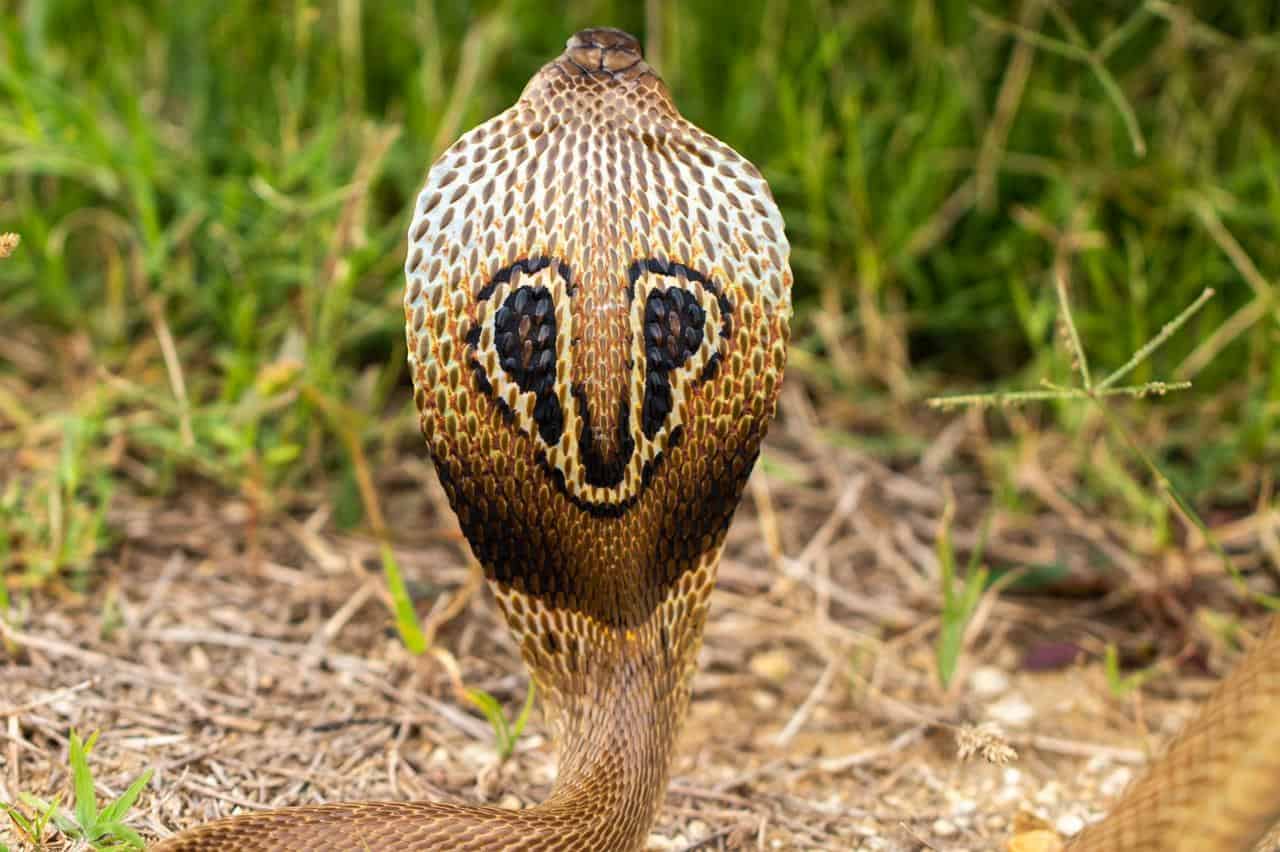
Indian coffee plantations aren’t just places for farmers to grow beans, but a thriving ecosystem. Many creatures flock in without invitation, as the towering coffee canopies are too thick and shady to resist. This includes Indian wolf snakes, and one that farmers would rather see the back of – the Indian cobra.
This 180cm venomous killer occupies most habitats, yet coffee forests are a particular hangout. One reason is the high amount of rodents living in them, darting beneath farmers’ feet. Encounters with the Indian cobra are common, and Indian coffee farmers must be constantly on their guard, even with sacks of beans in their arms. Indian cobras can be found on the shady ground, or bushy thickets on their edges. The one saving grace is that Indian cobras climb trees only rarely, so they probably won’t drop onto an unsuspecting coffee farmer’s head.
Some believe that Indian coffee tastes different, simply because the plantation ecosystems are so diverse. Perhaps there’s a touch of cobra in the mix as well. Indian coffee farmers can defend themselves with thick leather boots, but if a cobra fang penetrates, then the consequences include extreme swelling and lung failure. Indian cobras have a neurotoxic venom, and belong to the “big 4” of deadly Indian snakes.
| 2 | Smooth-scaled death adder |
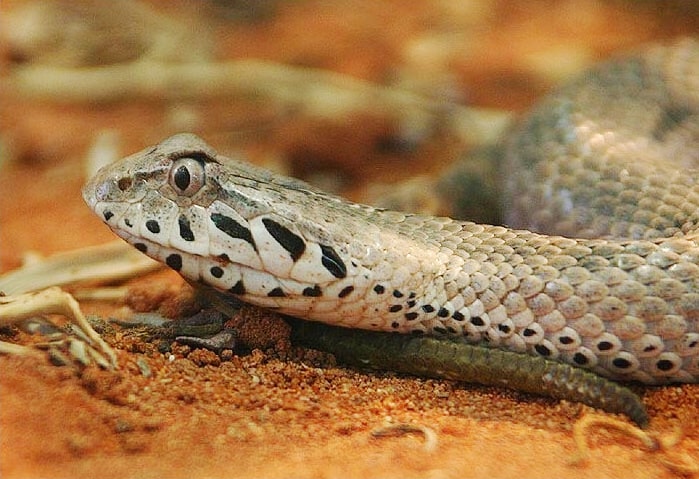
This species is the menace of New Guinea’s coffee plantations, including Indonesia in the west and Papua New Guinea in the eastern half of the island. The smooth sided death adder (Acanthophis laevis) is a relative of the common Australian version, and shares the same lazy lifestyle. They search for disguising thickets and bushes, and then lurk menacingly for days or even weeks, waiting for a small mammal to wander past.
Rodents are a top prey for Acanthophis laevis, and since coffee plantations are full of them, that’s where they love to lurk. They’re also found in woodlands and forests. Smooth-sided death adders avoid deserts like the plague. Their greatest fear is a bone dry landscape where there’s no undergrowth to lurk in.
These stealthy ways make Acanthophis laevis a nightmare for coffee farmers. A cobra you can see coming, as they’re so energetic, but death adders stay motionless for days. More positively, smooth scaled death adders are sometimes so relaxed that they barely react to human presence, even at distances of mere feet. When touched, they react furiously, so stepping on them is the biggest danger for coffee plantation workers.
| 3 | Red coffee snake |
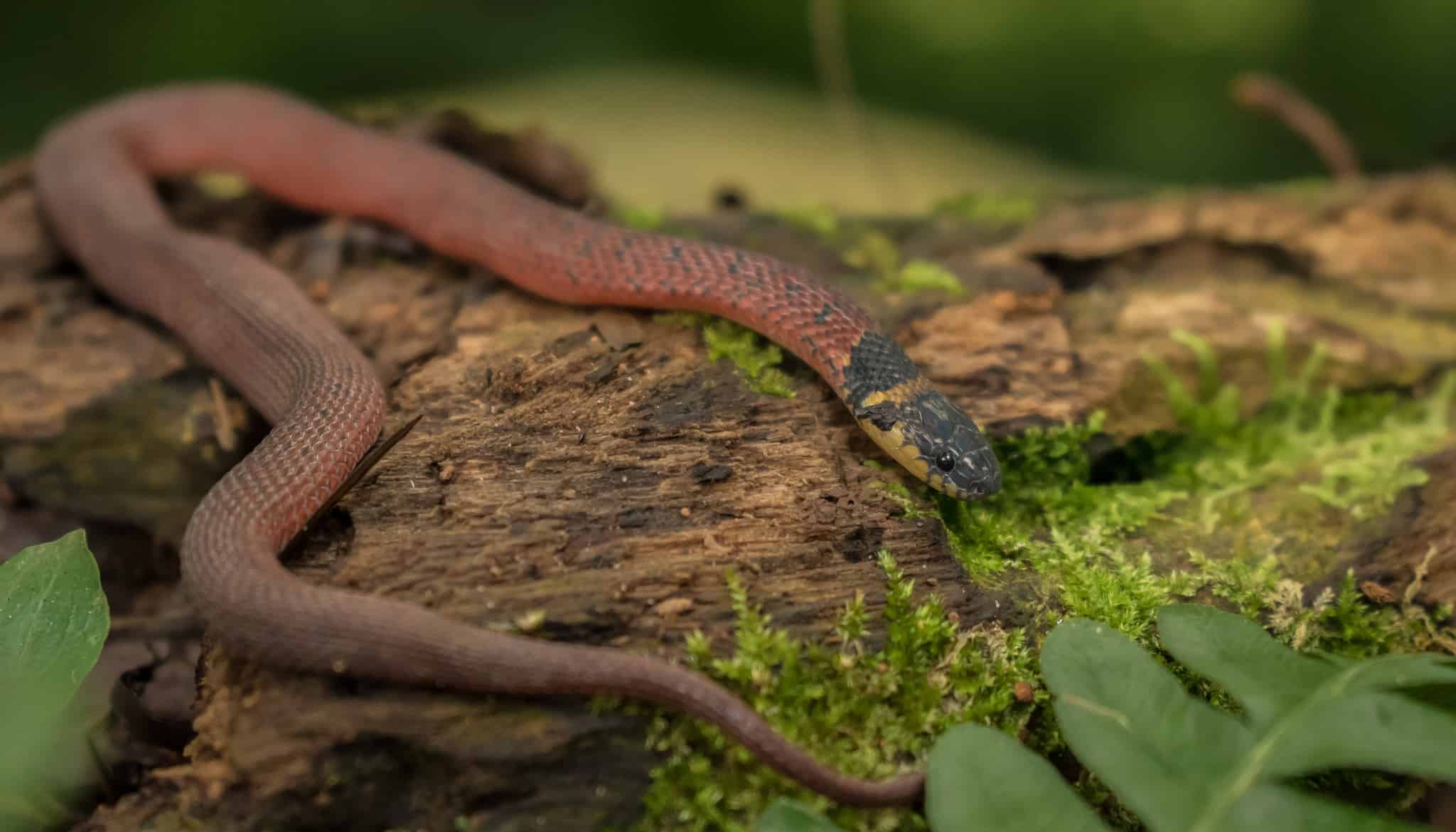
A harmless staple of Central America coffee plantations. The red coffee snake reaches no more than 30cm, and is a juicy red mixed with black markings, and a white/yellow neck collar. In a natural world, red coffee snakes would exclusively inhabit forests and woods, but the leagues of coffee plantations created by humans are a dream come true.
Ninia sebae sticks to low branches or rests on logs covered in lichen. The red coffee snake watches as young coffee pickers fill their baskets with beans nervously, wondering why nobody told them of the snake infestation. Fortunately, this species is far safer than the Indian cobra. Red coffee snakes lack any venom, and kill their prey via constriction. Being just 30cm, their bite is nothing to fear.
Forest snakes are a dime a dozen in Central America, yet red coffee snakes (and fellow Ninia members) particularly love coffee plantations for some reason. The exact characteristics are a mystery. Maybe the soil composition differs, or maybe it’s the tasty insects coffee attracts, which farmers are constantly trying to defeat with pesticides. These include coffee berry borers, coffee leaf miners, and red spider mites.
| 4 | Boa constrictor |
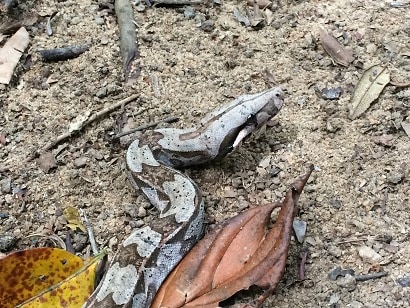
Boa constrictors can occupy virtually any habitat, and coffee plantations are no exception. They’re a hub of activity on the edge of the forest, and boa constrictors can’t resist poking their head in to see what’s going on. They normally like what they find, from the shady tree corridors to the abundance of rice rats darting around. The boa constrictor then sets up a base, much to the annoyance of plantation workers.
Though a globally feared icon of terror, boa constrictors are no threat to human beings, and normally coexist with bean pickers in peace. They climb these branches occasionally, but mainly stick to the ground. While they lurk in thickets in ambush, boa constrictors are far more active than a death adder, and prowl around slowly in search of scent trails. A coffee plantation worker could conceivably trip over one moving between coffee trees, and fall flat on his face. Great superstition surrounds boa constrictors, and farm workers unnecessarily club them to death.
Though unnerving, you could have 10 boa constrictors watching you at once as you pick coffee beans, and still not be in any danger. This famous species inhabits a large swathe of South America: Brazil, Venezuela, Paraguay, Columbia.
| 5 | Gaboon adder |
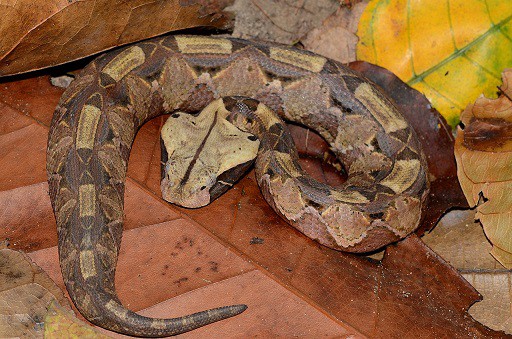
This coffee plantation snake is especially treacherous, as it has some of the greatest snake camouflage on Earth. It also has the largest fangs (2 inches), and the highest venom yield of any African snake. Gaboon adders inhabit over a dozen countries in central Africa (Nigeria, DRC), and are an ambush snake which stays still in the undergrowth like a tank about to set off. This is a thick-bodied snake which reaches a maximum of 205cm. Gaboon adders like woods, but not ultra dense rainforests, and coffee plantations fit this requirement.
Gaboon adders can unleash severe swelling and spontaneous bleeding. The next time you drink Kenyan coffee, remember that the beans could have matured just 2 metres from a menacing gaboon adder. Although black spitting cobras invade coffee plantations in Africa, they tend to move on more quickly, always seeking the next horizon. Gaboon adders are the most notorious coffee plantation snake of Africa. They also appear in cashew and tea plantations.
The only thing that saves gaboon adders from being impossible to spot is their thick body. Fortunately, they rarely attack unless touched, or approached to within several feet.
| 6 | Hoffman’s earth snake |
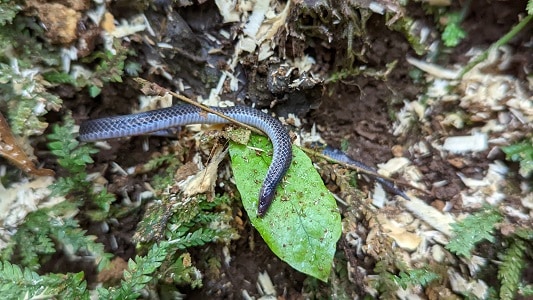
Found in Costa Rica and Panama, this is a coffee plantation snake which lurks in them snugly without anyone knowing. Hoffman’s earth snake is a simple soil dweller which forges tunnels in upper layers, and has smooth scales to glide through effortlessly. Forests are their home, in addition to mixed areas like gardens. For reasons unknown, Hoffman’s earth snake appears particularly commonly in coffee plantations. The workers have likely never heard of them; they’re most likely to meet one when lifting old vegetation and debris and getting a nasty shock.
Hoffman’s earth snake has beady eyes and a brown body, which blends into the soil below bushy coffee trees perfectly. If Hoffman’s earth snake flipped over, then it would be easier to spot, as it has a white belly, but they don’t like to make it too easy for people.
This is a non-venomous snake which poses no threat to coffee plantation workers, or people visiting them on guided tours. Another special feature is their iridescent scales, which reflect dazzling rainbow colours under the shine of torchlight. This small snake (30cm) is mainly an earthworm and insect eater, so it’s possible that swarms of eager coffee pests lure them in.
| 7 | Malayan pitviper |
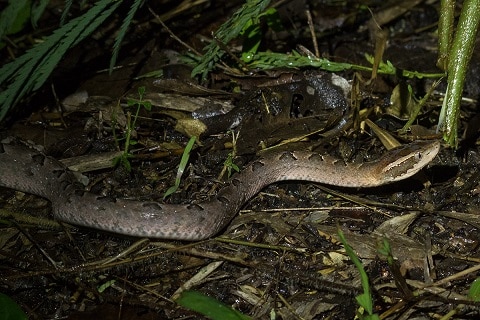
The Malayan pitviper may be the single deadliest creature in Vietnam. They cause the most annual snakebites, while in Thailand they cause 30.5%, according to a 2001-2002 study. Agricultural workers are hardest hit, including in rice, rubber and coffee plantations. The latter is one of their favourite hangouts. Like in India, a Vietnamese coffee field is a whole ecosystem, with wolf snakes, pitvipers and insects which only the most obscure expert could recognise.
This species reaches 1.2 metres and varies in colour from grey to pink. This is a slow snake rather than fast and adventurous like a cobra. Malayan pitvipers don’t care that coffee plantations are privately owned property, and will set up a base in them, regardless of the workers busying all around.
These days, Vietnamese coffee farmers are wising up, wearing protective boots and trousers. Malayan pitvipers stick to the ground, so legs and feet are the most common place they bite. Being so common in coffee plantations, antivenom has been rushed through development, and at least 3 dedicated species-level serums are now available. Still Vietnamese workers probably get annoyed when “may involve pitvipers” isn’t listed anywhere on the job description.
| 8 | Salmon-bellied racer |
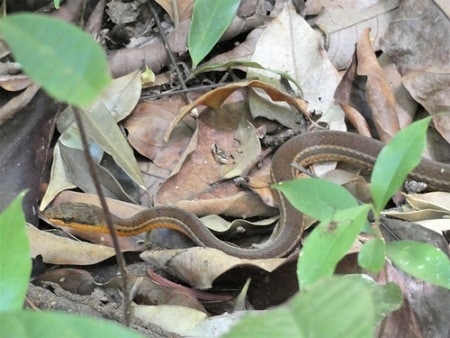
One of the most likely coffee plantations snakes to hiss at you from a tree. Salmon-bellied racers are common in central America (Nicaragua, Honduras), and are always slithering through coffee plantations as they complete their daily missions. Like a boa constrictor, this snake invades coffee plantations out of pure curiosity, to see if they offer glorious new prey opportunities.
According to a 2008 survey of coffee plantations in San Vito region, southwestern Costa Rica, salmon-belled racers were recorded repeatedly. This is a non-venomous species which could easily coexist with humanity in an idyllic world. Yet salmon-bellied racers have an aggressive personality which often lands them in trouble. They’re quick to bite, typically bringing the full force of a steel shovel down on their heads.
Salmon-bellied racers are officially classified as terrestrial, yet often climb trees to investigate scents in them. A coffee worker might be terrified by a hissing face mere inches from his own, after he hastily tried to turn his torch on at midnight. This snake could even land on a coffee worker’s head, if he spooked it while plucking off beans. The salmon-bellied racer can reach 1.5 metres.
| 9 | Red-tailed coral snake |
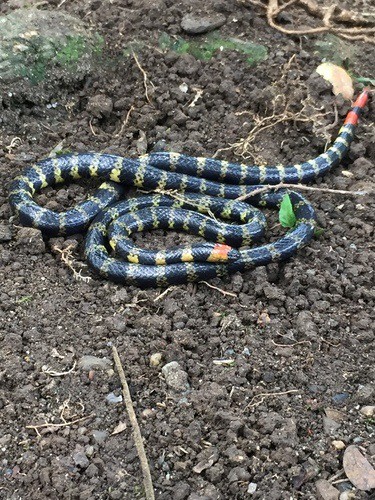
This deadly snake is easier to spot in coffee plantations than the gaboon adder, thanks to their bright red tail and head. On the other hand, they’re unadventurous and you could easily step on one if you’re checking the amount of beans you’ve just picked. Red-tailed coral snakes live in forests of Colombia and Panama (plus many more), and reach 140cm. Reports from coffee fields are numerous, making them a gentler-looking but actually far deadlier neighbour of the boa constrictor.
Red-tailed coral snakes have a potent neurotoxic venom, which consists of 60% three finger toxins and causes death by paralysis. Lesser symptoms include drowsiness and clumsiness. Brutal as it sounds, coral snakes cause less than 1% of snakebite deaths in the Americas.
They never pursue humans, including coffee farmers, and only bite if handled or brushed against. Red-tailed coral snakes dine largely on fellow snakes. In Panama, this includes their coffee field compatriot, Hoffman’s earth snake, with a length of 140cm versus 30cm. Micrurus mipartitus sticks to the ground, and will never leap onto a coffee farmer’s head while they harvest beans, or inspect them for ripeness.
| 10 | Common lancehead |
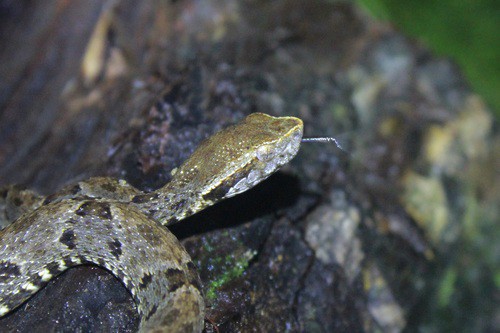
Boa constrictors are non-venomous while red-tailed coral snakes are shy. The common lancehead (Bothrops atrox) is perhaps the biggest danger in South American coffee plantations. This venomous snake inhabits a massive chunk of the continent’s north, including Brazil, Columbia and Venezuela. Their venom lacks neurotoxins, but unleashes swelling, haemorrhaging and necrosis in victims, coffee farmers potentially included. Bothrops atrox prefers forests, but unlike the black-speckled palm pitviper of Costa Rica, they don’t mind a bit of human modification. This brings coffee plantations into play.
Common lanceheads are found slithering along the ground, occasionally in trees, sending coffee workers scattering in their wake. They’re not hyperactive, yet search for prey actively, meaning that they often prowl around the bushy plantations for rats. Antivenom for Bothrops atrox was developed decades ago, so coffee workers can save their lives with a quick injection. The other possibility is that Bothrops atrox wish to enjoy coffee too, and nobody has ever given it to them. In frustration, they enter rage mode and start biting. A monthly coffee bean tribute might solve all the problems.
No matter how easy their bites are to treat, the fear that a common lancehead is lurking in your coffee plantation probably never wears off. This species reaches 125cm and varies wildly in colour.
